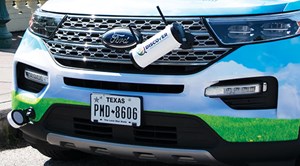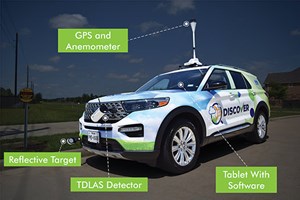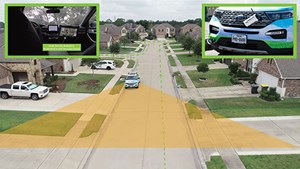March 2023 Vol. 78 No. 3
Features
First Look: Discover Advanced Mobile Leak Detection detects pipeline gas leak immediately
Corinna Hunt | Contributing Editor
(UI) — The key to discovering and repairing natural gas leaks before they become catastrophic is more vigilance, and that’s what Heath Consultants is striving to achieve with its new Discover Advanced Mobile Leak Detection (AMLD) system.

The new vehicle-mounted device uses tunable diode laser absorption spectroscopy, with resolution in parts per billion, and two lasers – one tuned for methane, which comprises the majority of natural gas, and one tuned for ethane.
“By having a methane and an ethane laser, we can differentiate pipeline gas, which has ethane in it, from non-pipeline gas being sewer, swamp, soil and marsh,” said Paul Wehnert, Heath’s executive vice president and chief marketing officer. “Because it can see in parts per billion, it has the ability to reach out quite a distance from the road, up to houses on both sides of the road, to detect potential gas leaks.”
Heath’s Discover AMLD incorporates the detector, mounted to the front of the vehicle, along with an anemometer to look at wind direction and GPS to look at latitude and longitude, both mounted on the roof. All equipment is designed to require minimal vehicle modifications and be “ruggedized” to withstand the elements, Wehnert added.
Natural gas detection happens immediately with Heath’s open-path laser technology. Other vehicle-mounted systems, typically pump-drawn, pull a sample of air through the front of the vehicle to an analyzer usually at the rear.
“You get a lot of dilution because you’re pulling a lot of air mixing in with gas,” he said. “Then you also get the delayed time: if you’re traveling down the road at 30 mph, it takes several seconds for the gas to be drawn into the vehicle, into the analyzer and then analyzed, and you’re already quite a ways down the road when you detect gas.”

In contrast, Discover AMLD’s open laser on the front of the vehicle means that when it reaches a plume of natural gas, it responds – without any dilution or delay.
Additionally, because one laser measures specifically for ethane, detection of pipeline gas is more accurate, with less false positives from natural methane sources, such as sewer or swamp gas.
It took a number of years to develop the parts-per-billion sensitivity to add the ethane detection capability, which is not in Heath’s TDLAS handheld units. The company’s second generation of handheld devices, released a few years ago, detect just methane in parts per million, and was the precursor to this latest technology.
“The idea with this device, because of the low-level sensitivity and smartness of the software platform, is utilities can now drive basically all the city streets and based on wind direction, and learn how much of their assets were covered by that vehicle driving down the street,” Wehnert explained.
“It also tells if there were some pipes that were just too far away from where the vehicle was, so it doesn’t feel it had a good-enough inspection. Those areas are then highlighted for people to walk.”
Traditional surveys done walking are more time-consuming and labor intensive. Discover AMLD can now give utility operators a rough idea of where a detected gas leak is, and then use a handheld tool to pinpoint the leak for repair.
“So it’s just looking at manpower and assets a little bit differently than how things were previously done,” he said.
The cost to purchase the new system hardware is just under $200,000. Competitive technologies, most of them pump-drawn, can cost three or four times as much. An additional option is to contract Heath to perform inspections for a utility company.

“In most cases, the utilities do a combination of both,” he said. “They own equipment and do it with their own people, but then they also outsource a percentage of it to a company like ourselves.”
With this new technology, utility companies can survey more ground and assets quickly, which means many of them are now going above and beyond the federal requirements, Wehnert pointed out. It’s also beneficial to public safety and the environment.
“You don’t want leaks out there that could lead to explosions or fires, and then you don’t want methane admitted to the atmosphere as a greenhouse gas,” Wehnert said. “That’s where, by having some of this newer technology, companies can eliminate some of these leaks from safety and environmental emissions standpoint.”
FOR MORE INFORMATION:
Heath Consultants, (713) 844-1300, heathus.com




Comments